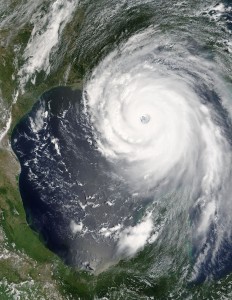Good morning, Whitewater.
Our week ends with an even chance of thunderstorms today, and a likelihood of them tonight. We’ll have a high today of eighty-one, with south winds of five to ten miles per hour.
On this day in 2005, Hurricane Katrina struck land:

on August 28, 2005. Via Wikipedia.
Hurricane Katrina was the deadliest and most destructive Atlantic tropical cyclone of the 2005 Atlantic hurricane season. It is the costliest natural disaster, as well as one of the five deadliest hurricanes, in the history of the United States. Katrina is the seventh most intense Atlantic hurricane ever recorded, part of the 2005 season that included three of the six most intense Atlantic hurricanes ever documented (along with #1 Wilma and #4 Rita). At least 1,833 people died in the hurricane and subsequent floods, making it the deadliest U.S. hurricane since the 1928 Okeechobee hurricane; total property damage was estimated at $108 billion (2005 USD),[1] roughly four times the damage brought by Hurricane Andrew in 1992.[3]
Hurricane Katrina formed over the Bahamas on August 23, 2005, and crossed southern Florida as a moderate Category 1 hurricane, causing some deaths and flooding there before strengthening rapidly in the Gulf of Mexico. The hurricane strengthened to a Category 5 hurricane over the warm Gulf water, but weakened before making its second landfall as a Category 3 hurricane on the morning of Monday, August 29, in southeast Louisiana. It caused severe destruction along the Gulf coast from central Florida to Texas, much of it due to the storm surge. The most significant number of deaths occurred in New Orleans, Louisiana, which flooded as the levee system catastrophically failed, in many cases hours after the storm had moved inland.[4] Eventually 80% of the city and large tracts of neighboring parishes became flooded, and the floodwaters lingered for weeks.[4] However, the worst property damage occurred in coastal areas, such as Mississippi beachfront towns; over 90 percent of these were flooded. Boats and casino barges rammed buildings, pushing cars and houses inland; water reached 6–12 miles (10–19 km) from the beach.
Google-a-Day asks a question about an analogy:
In “Eats, Shoots and Leaves”, what analogy does the author say that grammarians use for the relationship of punctuation to words?
